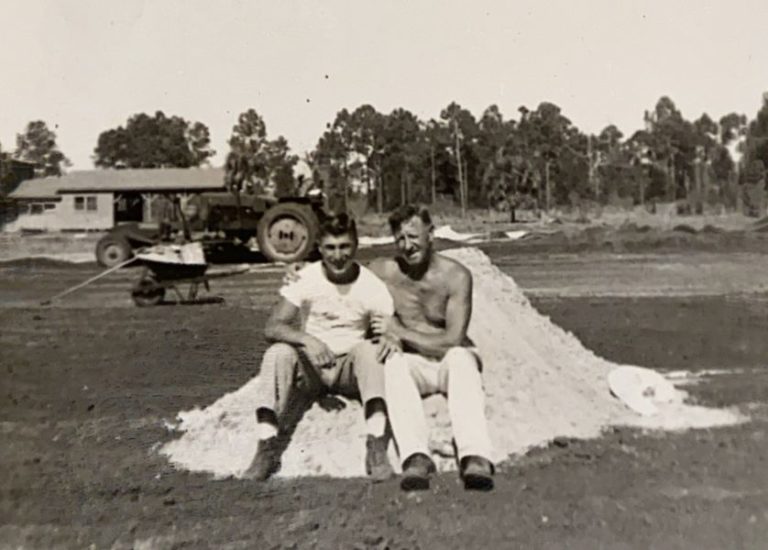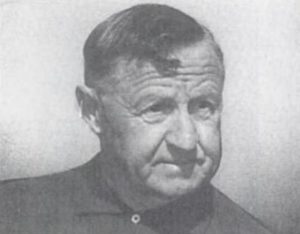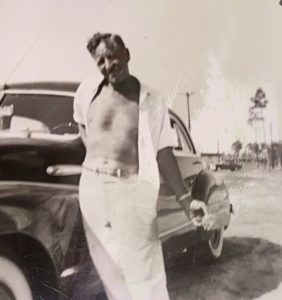By John Kmitta
Emil Bossard, former head groundskeeper for the Cleveland Indians, passed away in 1980. Unfortunately, his life and his work occurred prior to the founding of the Sports Turf Managers Association (now SFMA). As a result, despite being inducted into the Major League Baseball Groundskeepers Hall of Fame, Bossard did not garner the widespread recognition he truly deserved for his impact on the sports field management industry. However, the legacy of Emil Bossard lives on to this day.
“Emil was the greatest groundskeeper of all time,” said Hall of Fame Groundskeeper, George Toma. “He could do anything. He invented a nail drag, an edging shovel, rakes, and practices such as soaking clay in a bathtub; hand seeding that rivals any mechanical seeder seen today; and painted using a 4-inch paintbrush, which created sharp lines. He used bailing wire instead of string to lay out the arc. Emil would take a bucket, put seed in it, and scatter the seed with his hands. He taught us to push and pull to rake the seed into the soil.”
Born in Switzerland in 1891, Emil Bossard’s family immigrated to the United States when Emil was only one year old – ultimately settling in St. Paul, Minn. Bossard’s father eventually went on to run a hardware store and plumbing business. Emil Bossard – who became a naturalized citizen of the United States in 1908 – had been working as a laborer when he landed a job as in 1911 as groundskeeper for the St. Paul Saints minor league baseball team.
He was quoted as saying, “I stepped in and got the job. I moved right in, but I didn’t know a damned thing about the work.”
But he learned, and he worked at it, and he innovated, and ultimately went on to become head groundskeeper for the Cleveland Indians beginning around 1936. While working for the Indians, Bossard gained the nicknames “Doctor of the Diamond” and the “Evil Genius of Groundskeepers” for what was referred to at the time as “maximizing the home field advantage.” Depending on his team’s preferences and abilities, it is said that Bossard would tilt the base lines in or out, so balls were more likely to roll fair or foul; water the base paths to slow down opposing runners; adjust the height of cut on the infield to impact the speed of ground balls; and either soak or harden the ground in front of the plate depending on whether a sinkerball pitcher was on the mound for the Indians or their opponent.
Joe DiMaggio is quoted as having said, “The Yankees hated to come [to Cleveland], because our every defensive flaw was exploited by the Bossards the way they prepared the playing field.”
Bossard’s contributions were so critical that Indians manager Lou Boudreau called him “the tenth man in our lineup.” In 1955, Boudreau told Baseball Digest that he wouldn’t be surprised if Emil helped the Indians win as many as 10 games per year.
“This is a game of inches,” Emil said in an interview. “An inch is often the difference between a base hit and an out. We try to have the inches go our way.”
During Bossard’s tenure, the team won the World Series in 1948 and a pennant in 1954. According to Toma, when the Indians won the World Series in 1948, the players bought Bossard a Buick. Bossard would later use that Buick to tire roll the infield dirt, said Toma.
Bossard also built many fields during the 1940s and ‘50s on military bases that were decommissioned following World War II.
“His baseball and football fields were excellent. They looked like they were laser graded,” said Toma. “I worked with Emil in 1948 in Virginia on a naval air station, and then again in 1949 in Georgia on an Air Force base. In 1950, we built six fields at the old Daytona Beach Naval Air Station.”
Toma pointed out that he and Bossard did all that work without the benefit of modern equipment or engineered soil mixes. They would have to go in search of infield dirt and then work the soil, which is why Bossard invented the nail drag, Toma added.
“Emil could close his eyes and create a better field than anyone else,” said Toma.
Bossard went on to manage the field for the Indians’ Spring Training site – Hi Corbett Field in Tucson, Ariz. By 1959, according to a report in the Tucson Daily Citizen, Emil Bossard had been named, “The No. 1 groundskeeper in all baseball.”
In 1961, Bossard retired as head groundskeeper of the Cleveland Indians – a position taken over by his son, Harold. He moved to Tucson, where he continued to work at Hi Corbett Field until 1970. Emil Bossard died on May 6, 1980, but left behind a lasting legacy.
“The cheapest insurance, to this day, is a great, safe playing field. Emil knew that,” said Toma. “The techniques and equipment we have today – we have Emil to thank for that. There is nobody else in this industry that could shine Emil Bossard’s shoes – they can only hope to follow in his footsteps.”
A mighty oak
Many of Emil’s own family members did indeed follow in his footsteps – a tradition that carries on to this day.
Emil and his wife Elizabeth (Lizzie) had three sons – Harold, Marshall and Eugene (Gene). Harold and Marshall were groundskeepers for the Cleveland Indians and Cleveland Browns, and Gene was a groundskeeper for the Cleveland Indians and Chicago White Sox. Emil’s grandsons Roger (White Sox), Bruce (Indians and Browns) and Brian (Indians, Browns, Yankees and Chargers) carried on the family tradition. Great-grandson James Bossard worked for the Indians and Browns, and is currently a groundskeeper at Case Western Reserve University. And Emil’s great-great-grandson, Andrew Bossard, is assistant groundskeeper with the Cleveland Browns – making it five generations of Bossards managing professional sports fields.
Said Toma, “What has made the Bossards successful is the same thing that made me successful. It’s that ‘and then some’ attitude. You do the job…and then some. That is what distinguishes the mediocre from the great.”
“I started working for the Browns and Indians at old Cleveland Municipal Stadium at 15 years old, in 1975,” said James Bossard (Emil’s great-grandson). “At that time, Emil would come in for weeks at a time during summer baseball season from his home in Tucson. We mostly talked about the playing surface. He once complimented me on my straight lines as I was fertilizing with a walk-behind spreader. He was thrilled to be walking the strikingly nice turfgrass in the warm sunshine – maybe it was more of a shuffle by that time.”
James added that Emil was like a giant oak tree that dropped the acorns that grew into the great groundskeepers and the higher standards that are now the norm in the industry.
“He loved a great surface, and I am 100 percent positive that he would love the high standards and the current state of the industry – better turfgrass cultivars, better equipment, sophisticated drainage and irrigation, better pesticides, and well-thought-out soil profiles,” said James. “Emil was the first guy to look at where baseball is played and not look at it as a field – he saw it as a playing surface. He loved the work and surpassing the challenges presented; and was dedicated to the highest degree – probably a perfectionist.”
In 2011, James accepted an award on Emil’s behalf.
“I think so many generations of family have done this job for a few reasons,” said Andrew Bossard (Emil’s great-great-grandson). “One is that it was always a job that was available to them. At the old stadium, it was always a Bossard in charge. Two is that I think a lot of us just took to it – and maybe felt that it was chosen for us. I know for me it’s all I ever really knew.”
Andrew added that he remembers conversations among his father, grandfather and even great-grandfather. “It was always just talking about fields, dirt, players and grass,” he said. “I always felt like this is what I should do. I ended up starting with the Browns when I was 17 years old. I’m now 32, and have basically spent half my life in one place doing the same job. And it makes me proud knowing that I’m doing the ‘family business.’ Even though it’s a new stadium, I’m still standing in the same spot that four generations before me worked.”
Andrew added that he will likely be the last Bossard to do this work, but that he still looks forward to taking his young son to work with him and teaching him about the family business.
“Emil’s legacy lives on when my father, Roger and I show up to work every day using those family secrets passed down from dinner table to dinner table over the last 90 years. I can’t speak for Roger or my dad, but that makes me proud. And I hope that all those who came before me are looking down and are proud.”
Emil Bossard was inducted into the Major League Baseball Groundskeepers Hall of Fame in 2012.
John Kmitta is associate publisher and editorial brand director of SportsField Management magazine.




